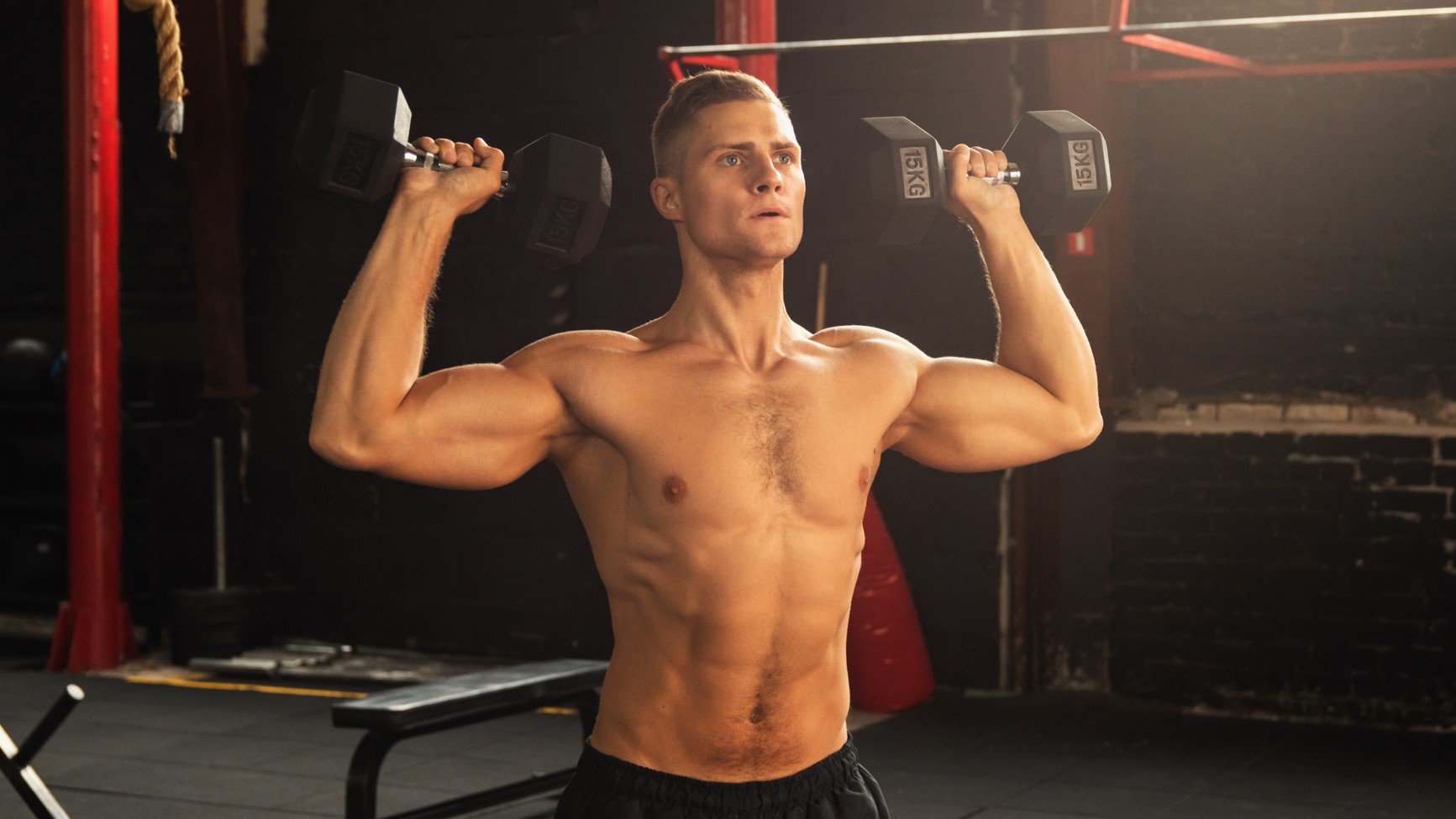I did the dumbbell push press every day for a week — here's what happened to my body

If you’re interested in working out at home, the one piece of equipment I think you need is a set of dumbbells. Sure, you can rely on body-weight exercises, which are excellent and you can do them anywhere, but dumbbells sitting on the floor are like a rebuke — they dare you to use them — and they are, ultimately, better for building muscle, if that’s your goal. They also allow for easier and greater variety, as is the case with the dumbbell push press.
If you are still working out from home, check out the best adjustable dumbbells on test here.
What is it?
This move looks a bit like a standard shoulder or overhead press, where you lift dumbbells above your head, but with the dumbbell push press, you also bend your knees, so that as you rise the momentum makes it easier to raise the weights. This means you work your glutes, quads and hamstrings as well as your arms (mostly the triceps), chest (pectorals), shoulders (deltoids) and trapezius (upper back). In addition, for good form you’ll be engaging your core, though this is not a core exercise. It just likes to be involved.
How to do a dumbbell push press

- Begin in a standing position, feet hip-width apart. Hold a dumbbell in each hand (make sure they’re a weight you can lift relatively easily, but that will leave you fatigued at the end of your sets). Your palms should be facing in and your elbows pointing straight ahead.
- Engage your core, bend your knees (not too much, this is not a squat; you’re looking for some leg drive), lean at the hips slightly and inhale.
- As you exhale, stand up straight, driving powerfully through your heels, and raise the weights straight over your head. Push through your shoulders and upper arms. You don’t need to turn your palms to face them forward, as this puts extra strain on your shoulders.
- Hold the weights above your head for a moment, then lower them back to your shoulders. That’s one rep, but there’s no waiting around here. Immediately bend your knees again for the next one. Aim for three sets of 8-10.
I did the dumbbell push press every day for a week — here's what happened
Day 1
I have not done much arm work in recent weeks, owing to a self-diagnosed bout of tennis elbow. Like most people who develop the painful condition, I don’t play tennis (I don’t own a preppy tennis sweater, for a start), so I prefer to call it lateral epicondylitis, which generated at least momentary sympathy when I explained to friends why I couldn’t get the lid off a jar of mayo.
I started off with 15lb weights and did the move in a gym, so I could easily watch my form, as could everyone else present — always a joy. I did three sets of 10, but slowly, and I listened for any screams of protest from my forearm tendons. There were none. My upper arm muscles twitched for a while afterwards, but this reaction has never bothered me. It’s not uncommon after exercise (it’s estimated that it occurs in 70% of healthy people at some point), especially if the muscles have been overworked or were not warmed up (guilty). That said, if you’re having frequent muscle twitches, and are anxious about it, see your healthcare provider.
Day 2
I was feeling the effects of day one in my shoulders and upper back more than anywhere else. I decided I’d overdone the weight so I lowered to 12lb dumbbells and did three sets of 15 with good form. I felt the back muscles enjoying the stretch and lift, welcoming the workout. However, I wasn’t noticing anything in my glutes and legs, even though I was bending and rising correctly.
Day 3
The soreness in my shoulders had vanished. I guess they’d decided to stop complaining, as the exercise was continuing regardless. I raised the weights to 14lb and did three sets of 15 again. At the end I still did not feel much in my legs and glutes. I wondered if I’d have to go lower or add weight, but this is not a dumbbell squat to overhead press. The extra weight made things harder and I noticed a tendency to let my arms hover by my head. They should be straight up, but don’t lock out your elbows.
Get instant access to breaking news, the hottest reviews, great deals and helpful tips.
Day 4
I took more time with the move and got more from it (not a surprise, I know). When you bend, don’t let your knees creep ahead of your toes, as this means you’re bending too much and too far forward. Maintain a straight back throughout. If you have tight shoulder muscles or are not paying attention, you may find your arms drifting out, so that your palms are facing forward. Keep your upper arms close to your chest, elbows forward. As you tire, the weight of the dumbbells might pull your arms back when you straighten them. Correct this immediately or take a break, or you risk a shoulder or lower back injury, and a hole in your floor.
Day 5
Still confounded by the lack of an impression on my lower body, I add five reps to each set, and concentrated on working my glutes as I rose, but this felt like I was overdoing one aspect of the move at the expense of the other moving parts. However, I also noticed my lateral epicondylitis (see how impressive that sounds!) was bothering me less than it had done in weeks. Disclaimer: this move is not a cure for the condition. Rest is the way to go, and I’d been resting for weeks.
Day 6
Three sets of 15 with 15lb weights. On the last set, I didn’t bend my legs. The move was, not surprisingly, harder, but I enjoyed it more. The momentum you generate from the bending and rising does make it easier to lift the weight, but, for me, it wasn’t doing much else.
Day 7
I finished the week by adding five reps to each set. This is an excellent move for the upper body, and it improves coordination, but I think that if you want to also work your legs and glutes, the squat to overhead press is a better option. If you’re new to weights, start off with this one and progress from there.
After seven consecutive days, the muscles in my shoulder, chest and back felt stronger following the enforced time off. I know it’s not possible to build observable muscle in such a short time, but that didn’t stop me from tentatively asking my partner if I looked a little, you know, broader. More powerful. “Yes,” she allowed, “and you also seem taller and your hair is wavier.” “Be nice,” I shot back, “I have a medical condition of the forearm and it has a Latin name. Latin!” Then I squeezed through the doorway and left her to rue her sarcasm. You never know, it could happen.
More from Tom's Guide
- I did a single-leg wall sit every day for a week — here's what happened to my legs
- I worked out like Taylor Swift for a week — here's what happened
- Forget sit-ups — this 3-move ab workout chisels concrete core muscles in 15 minutes
John is a writer and editor based in London. He was worked for magazines such as Runner’s World, Men’s Health, Women’s Health and Cosmopolitan. A keen runner, what he lacks in ability he makes up for with enthusiasm and excuses.

